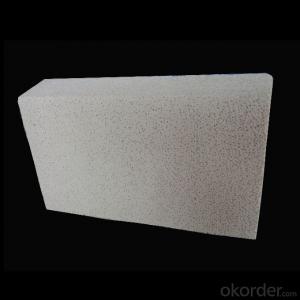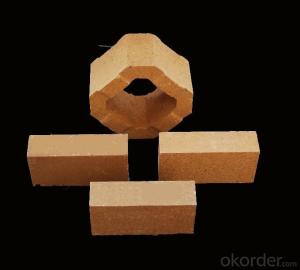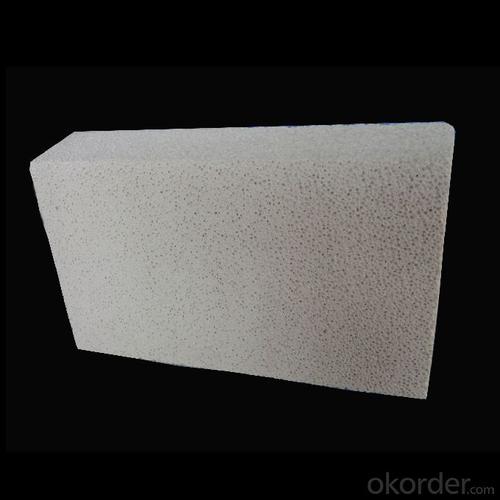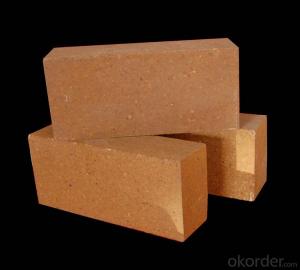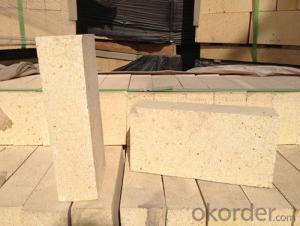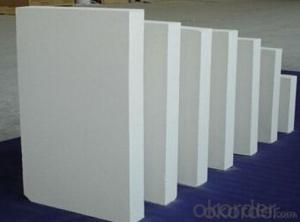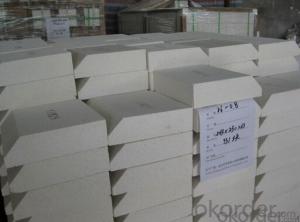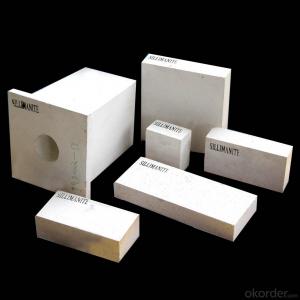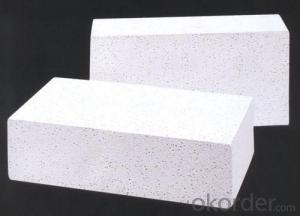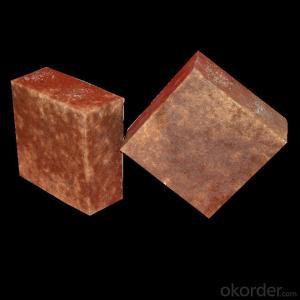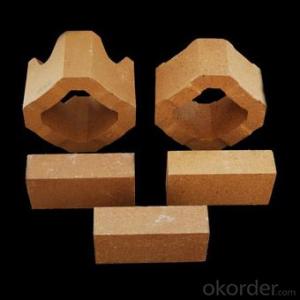Insulating Fire Brick - Refractory Aluminium Magnesium Carbon for Steel Ladle
- Loading Port:
- Shanghai
- Payment Terms:
- TT OR LC
- Min Order Qty:
- 10 m.t.
- Supply Capability:
- 100 m.t./month
OKorder Service Pledge
OKorder Financial Service
You Might Also Like
Quick Details
| Place of Origin: | (Mainland) | Shape: | Block | Material: | Alumina Cement |
| Al2O3 Content (%): | ≥60 | MgO Content (%): | ≥12 | Refractoriness (Degree): | 1770°< Refractoriness< 2000° |
| Model Number: | YH-AMC60 | Brand Name: | Bulk density: | ≥2.85 | |
| Apparent porosity: | ≤8 | C: | ≥6 | compressive strength: | ≥45 |
Packaging & Delivery
| Packaging Detail: | The refractory aluminium magnesium carbon insulating fire bricks for steel ladle is packed on wooden pallets with three layers water-proof shrink film and tightened with plastic/steel bandages,when in the transportation process,we should pay attention to moisture-proof and light handling. |
| Delivery Detail: | 7-15 working days |
Specifications
1.High temperature resistance&spalling resistance&anti erosion
2.Approved by SINOSTEEL
3.Premium service
4.ISO certificate
Refractory Aluminium Magnesium Carbon Insulating Fire Brick for Steel Ladle 
YH-AMC series refractory aluminium magnesium carbon insulating fire bricks for steel ladle are shaped by using top grade bauxite and corundum as aggregates and phenolic resin as binder and focusing on strengthen the matrix.It has the characteristics of corrosion resistance,spalling resistance,high strength,anti erosion and etc.,applicable to the ladle bottom and wall parts.
On the basis of Al-Mg-C Bricks,YH-MAC series magnesia alumina carbon bricks are strengthened the corrosion resistance and spalling resistance of materials by adjusting the process and technology,applicable to the ladle bottom,wall parts,etc.,to improve the ladle service life signigicantly.
Main Chemical Compositions and Physical Properties
| Items | Al-Mg-C Bricks | Mg-Al-C Bricks | |||||
| AMC-60 | AMC-65 | AMC-70 | AMC-75 | MAC-75 | MAC-75 | ||
| Chemical Compositions (%)≥ | MgO | 12 | 10 | 8 | 8 | 75 | 70 |
| Al2O3 | 60 | 65 | 70 | 75 | 10 | 15 | |
| C | 6 | 6 | 6 | 6 | 6 | 6 | |
| Apparent Porosity(%)≤ | 8 | 8 | 8 | 8 | 8 | 8 | |
| Bulk Density(g/cm³)≥ | 2.85 | 2.9 | 2.95 | 2.95 | 2.9 | 2.9 | |
| Compressives Strength(Mpa)≥ | 45 | 45 | 45 | 45 | 45 | 45 | |
Product Show of Refractory Aluminium Magnesium Carbon Insulating Fire Brick
Production Process of Refractory Aluminium Magnesium Carbon Insualting Fire Brick 
The production process of our refractory brick weather from the raw materials to the finished products inspection is strictly controled so that we can best service our client.laying solid foundation quality management to scientific and rational control system make high quality products.Scientific and rational control system is a prerequisite for the production of high quality refractories, Luoyang yuanhua matellurgical materials co., LTD always adhere to scientific and reasonable control to realize all-round control of production process, using the most advanced testing equipment and production equipment, strict quality control of raw materials to the finished product, put an end to the occurrence of unqualified products. In order to guarantee the high quality of the products, the company set up in the industry of advanced quality testing laboratory.
- Q: What is a JQK composite lightweight thermal insulation brick?
- 1. structural layer2. leveling layer3. waterproof layer4. thermal insulation layer and decorative layer
- Q: Can insulating fire bricks be used for insulation in gas furnaces?
- Yes, insulating fire bricks can be used for insulation in gas furnaces. Insulating fire bricks are made from lightweight materials such as clay and other minerals, which have excellent insulating properties. They are designed to withstand high temperatures and are commonly used in industrial applications, including gas furnaces. These bricks help to minimize heat loss, improve energy efficiency, and maintain high temperatures within the furnace. Additionally, insulating fire bricks are resistant to thermal shock and can withstand the corrosive effects of gases and chemicals present in gas furnaces. Therefore, they are a suitable choice for insulation in gas furnaces.
- Q: Are insulating fire bricks suitable for insulation in boilers?
- Yes, insulating fire bricks are suitable for insulation in boilers. Insulating fire bricks are made from lightweight materials such as clay and alumina, which have excellent insulating properties. They have a low thermal conductivity, meaning they are effective at preventing heat transfer and can help to significantly reduce heat loss in boilers. Additionally, insulating fire bricks are resistant to high temperatures, making them suitable for use in boilers where high heat is generated. They are also durable and can withstand the harsh conditions inside a boiler, including exposure to intense heat and corrosive gases. Overall, insulating fire bricks are a popular choice for boiler insulation due to their thermal efficiency and ability to withstand high temperatures.
- Q: Are insulating fire bricks resistant to flame impingement?
- Yes, insulating fire bricks are resistant to flame impingement.
- Q: Are insulating fire bricks resistant to phosphorus pentoxide?
- Yes, insulating fire bricks are resistant to phosphorus pentoxide.
- Q: Can insulating fire bricks be used in the construction of ceramic fiber kilns?
- Yes, insulating fire bricks can be used in the construction of ceramic fiber kilns. Insulating fire bricks are designed to provide thermal insulation and reduce heat loss in high-temperature applications. They have excellent insulating properties, with low thermal conductivity, which makes them ideal for use in kilns where high temperatures need to be maintained. By using insulating fire bricks in the construction of ceramic fiber kilns, it is possible to enhance the overall energy efficiency of the kiln and improve its performance. However, it is important to ensure that the insulating fire bricks are compatible with the specific requirements and operating conditions of the ceramic fiber kiln to ensure optimal results.
- Q: Can insulating fire bricks be used for insulation in refractory lining repair?
- Yes, insulating fire bricks can be used for insulation in refractory lining repair. Insulating fire bricks are made from lightweight materials that have excellent thermal insulation properties, making them ideal for use in high-temperature applications such as furnaces, kilns, and other refractory lining structures. These bricks have low thermal conductivity and high resistance to thermal shock, allowing them to effectively insulate and protect the refractory lining from heat, preventing heat loss and reducing energy consumption. Moreover, insulating fire bricks are easy to install and replace, making them a cost-effective choice for refractory lining repair.
- Q: Are insulating fire bricks suitable for use in residential fireplaces?
- Insulating fire bricks can be suitable for use in residential fireplaces, depending on the specific requirements and preferences of the homeowner. Insulating fire bricks are designed to have a low thermal conductivity, which means they can effectively retain heat and prevent it from escaping the fireplace. This can result in a more efficient and effective heating of the room, as less heat is lost through the bricks. Additionally, insulating fire bricks are lightweight and easy to handle, making them a convenient option for homeowners who may want to install or replace bricks themselves. They are also durable and resistant to high temperatures, ensuring that they can withstand the intense heat produced by the fire. However, it is important to note that insulating fire bricks may not be the best choice for everyone. Traditional fire bricks are denser and have a higher thermal mass, which means they can absorb and radiate heat for a longer period of time. This can create a more consistent and long-lasting heat output, which some homeowners may prefer. Ultimately, the decision to use insulating fire bricks in a residential fireplace should be based on the specific needs and preferences of the homeowner. Consulting with a professional fireplace installer or seeking advice from a reputable supplier can help ensure that the chosen bricks are suitable for the intended use.
- Q: Can insulating fire bricks be cut to size?
- Yes, insulating fire bricks can be cut to size using various cutting tools such as saws or knives.
- Q: What is the typical lifespan of insulating fire bricks in high-temperature applications?
- The typical lifespan of insulating fire bricks in high-temperature applications can vary depending on various factors such as the temperature reached, the specific type and quality of the brick, and the conditions under which it is used. However, on average, insulating fire bricks can last anywhere from several years to several decades in high-temperature applications.
Send your message to us
Insulating Fire Brick - Refractory Aluminium Magnesium Carbon for Steel Ladle
- Loading Port:
- Shanghai
- Payment Terms:
- TT OR LC
- Min Order Qty:
- 10 m.t.
- Supply Capability:
- 100 m.t./month
OKorder Service Pledge
OKorder Financial Service
Similar products
Hot products
Hot Searches
Related keywords
